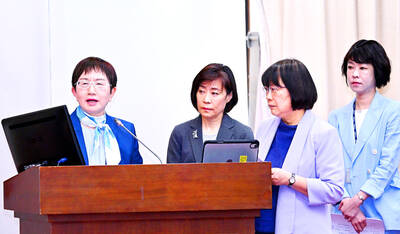Apple Inc’s major iPhone assemblers are among the companies expected to win approval to participate in a US$6.6 billion stimulus program to bring manufacturing to India, people familiar with the matter said, a potentially seismic shift as the world’s most valuable company diversifies beyond China.
The Indian government at a Cabinet meeting tomorrow is expected to approve a plan aimed at bringing US$150 billion in mobile-phone production to the nation over the next five years, said the people, who asked not to be identified because the matter is private.
Among the dozen phone makers already cleared by a high-powered government committee are Apple’s primary supplier, Hon Hai Precision Industry Co (鴻海精密), known internationally as Foxconn Technology Group (富士康科技集團), which had submitted two applications, as well as its Taiwanese peers Wistron Corp (緯創) and Pegatron Corp (和碩), the people said.
The three firms make virtually every iPhone sold globally in sprawling factories mainly in China.
Under the Production Linked Incentive (PLI) program, manufacturing incentives are to rise each year in an ongoing effort to entice the world’s biggest smartphone brands to make their products in India and export to the world.
Besides the Apple contractors, Samsung Electronics Co is the only other applicant for the five slots allotted to foreign companies.
China’s largest phone makers Huawei Technologies Co (華為) and BBK Group (步步高集團), which manufactures brands such as Oppo (歐珀) and Vivo (維沃), are conspicuous by their absence.
Amid rising trade and political tensions between the US and China, India is betting that many global brands would be keen to reduce their dependence on China.
If successful, the program could set in motion a shift in electronics manufacturing in the next five years.
“It’s a thoughtful move by the government aimed at wooing Apple to bring significant iPhone manufacturing to India because, when the iPhone maker shifts, an entire ecosystem follows,” said Hari Om Rai, chairman and founder of Lava International Ltd, India’s largest phone maker. “The next five years will be dramatic, and India could become the new China in phone manufacturing.”
Lava, based in the New Delhi suburbs, is among the Indian phone makers applying for manufacturing incentives, along with Karbonn Mobiles India Pvt Ltd and Dixon Technologies India Ltd.
To receive the incentives, foreign manufacturers, including Foxconn, Wistron and Samsung, must commit to specific investment and production targets of devices that sell for at least 15,000 rupees (US$204); Indian phone makers would have no such restrictions.
Indian Minister of Electronics and Information Technology Ravi Shankar Prasad last month told reporters that Apple accounts for 37 percent and Samsung 22 percent of global sales revenue from mobile phones.
The incentive scheme would “increase their manufacturing base manifold in the country,” the ministry said in a statement.
Apple did not respond to requests for comment.
Pegatron, the second-largest iPhone assembler after Foxconn with a number of factories in China, in July announced that it would set up a plant in India.
Apple accounts for more than half of Pegatron’s business. If approved, Pegatron’s first Indian factory would be eligible for PLI, the people said.
In the next five years, India could attract an additional 10 percent of global handset production, Credit Suisse Group AG said in a note.
Although the nation is the world’s second-largest handset market, with plenty of room for domestic sales growth, the government’s clear aim is to eventually become a global manufacturing colossus to rival China.
Almost two-thirds of the stimulus program is targeted at the export market, the people said.
Pankaj Mohindroo, chairman of the India Cellular and Electronics Association, a trade group that represents leading phone makers including Apple, Oppo and Xiaomi Corp (小米), said that incoming handset makers would be accompanied by a host of smaller sub-assemblers and component makers, expanding the sector to seven times its current size in the next five or more years.
“India’s incentive scheme will be a game-changer that will make the country No. 1 in mobile manufacturing, or at least a close No. 2, by 2025,” Mohindroo said.

‘SWASTICAR’: Tesla CEO Elon Musk’s close association with Donald Trump has prompted opponents to brand him a ‘Nazi’ and resulted in a dramatic drop in sales Demonstrators descended on Tesla Inc dealerships across the US, and in Europe and Canada on Saturday to protest company chief Elon Musk, who has amassed extraordinary power as a top adviser to US President Donald Trump. Waving signs with messages such as “Musk is stealing our money” and “Reclaim our country,” the protests largely took place peacefully following fiery episodes of vandalism on Tesla vehicles, dealerships and other facilities in recent weeks that US officials have denounced as terrorism. Hundreds rallied on Saturday outside the Tesla dealership in Manhattan. Some blasted Musk, the world’s richest man, while others demanded the shuttering of his

Taiwan’s official purchasing managers’ index (PMI) last month rose 0.2 percentage points to 54.2, in a second consecutive month of expansion, thanks to front-loading demand intended to avoid potential US tariff hikes, the Chung-Hua Institution for Economic Research (CIER, 中華經濟研究院) said yesterday. While short-term demand appeared robust, uncertainties rose due to US President Donald Trump’s unpredictable trade policy, CIER president Lien Hsien-ming (連賢明) told a news conference in Taipei. Taiwan’s economy this year would be characterized by high-level fluctuations and the volatility would be wilder than most expect, Lien said Demand for electronics, particularly semiconductors, continues to benefit from US technology giants’ effort

ADVERSARIES: The new list includes 11 entities in China and one in Taiwan, which is a local branch of Chinese cloud computing firm Inspur Group The US added dozens of entities to a trade blacklist on Tuesday, the US Department of Commerce said, in part to disrupt Beijing’s artificial intelligence (AI) and advanced computing capabilities. The action affects 80 entities from countries including China, the United Arab Emirates and Iran, with the commerce department citing their “activities contrary to US national security and foreign policy.” Those added to the “entity list” are restricted from obtaining US items and technologies without government authorization. “We will not allow adversaries to exploit American technology to bolster their own militaries and threaten American lives,” US Secretary of Commerce Howard Lutnick said. The entities

Minister of Finance Chuang Tsui-yun (莊翠雲) yesterday told lawmakers that she “would not speculate,” but a “response plan” has been prepared in case Taiwan is targeted by US President Donald Trump’s reciprocal tariffs, which are to be announced on Wednesday next week. The Trump administration, including US Secretary of the Treasury Scott Bessent, has said that much of the proposed reciprocal tariffs would focus on the 15 countries that have the highest trade surpluses with the US. Bessent has referred to those countries as the “dirty 15,” but has not named them. Last year, Taiwan’s US$73.9 billion trade surplus with the US